SURVEY: Most Common Shift Types Used by Iowa Fire Departments
Our team wanted to look at what shift types (24/48, 48/96, California Swing, Paid-on-Call, Volunteer, etc.) are used by Iowa fire departments. There is an active debate on what type of shift structure is best for firefighter health, staffing considerations, and overall performance. While we can’t say which shift type is most ideal, we can share what chiefs in Iowa have to say about the subject. We will also explore additional data collected in the survey. This includes how many firefighters are in each department, call requirements for volunteer fire departments, paged out vs. on call basis, etc.
To our knowledge, this is the first survey to include questions about shift types and scheduling. The National Fire Department Census has previously published census data covering Iowa fire departments. This included a complete headcount of firefighters at each department. However, the census only provides organization type, number of active firefighters, and other basic information. Our survey was designed to probe deeper questions about fire shift scheduling.
Who did we contact? All fire chiefs in Iowa with publicly available contact information and resident population of over 1,000 residents. One hundred eighty-one fire chiefs were contacted. Fifty-seven responded with survey information.
Department Types
First, we wanted to sort out what type of department we were talking to in each instance. Full-time departments have firefighters working full-time and are considered “career.” Volunteer departments are staffed with volunteers, whether or not they are reimbursed in some way. Hybrid departments have some combination of full-time, part-time, and volunteer elements.
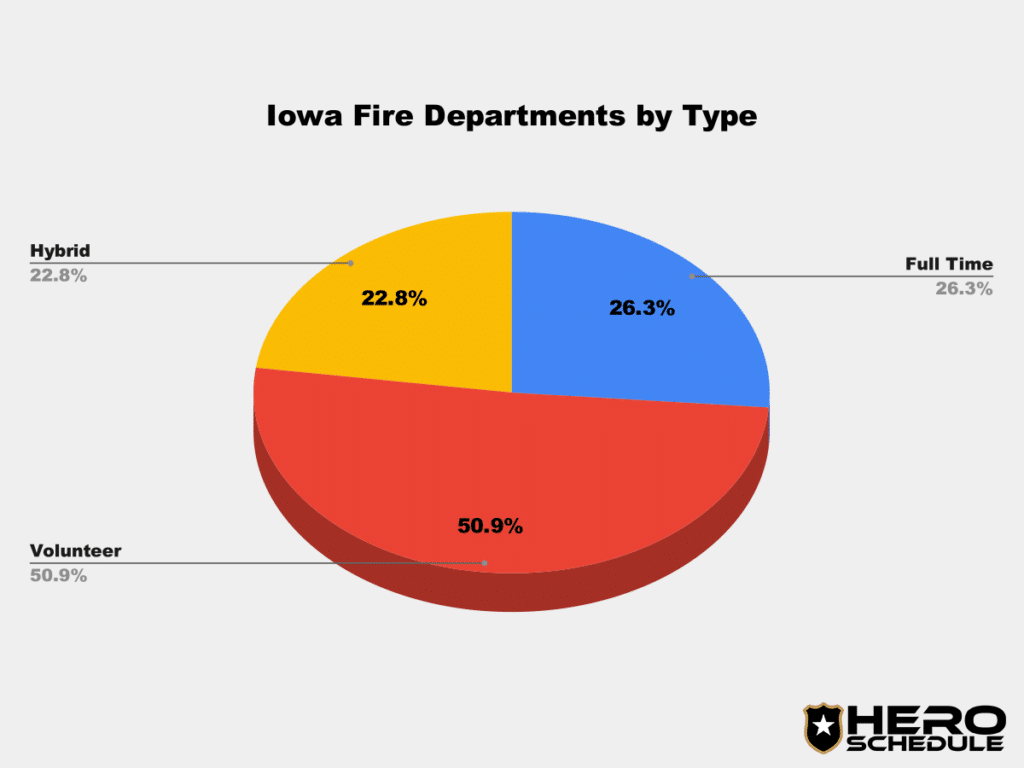
| Answer Choice | Percentage |
|---|---|
| Full-Time | 26% |
| Volunteer | 51% |
| Hybrid | 23% |
The majority of fire departments in our survey are volunteer departments (51%). This is followed by full-time departments (26%) and hybrid departments (23%).
Full-Time Fire Department Shift Types
All full-time fire departments were asked what shift types they use.
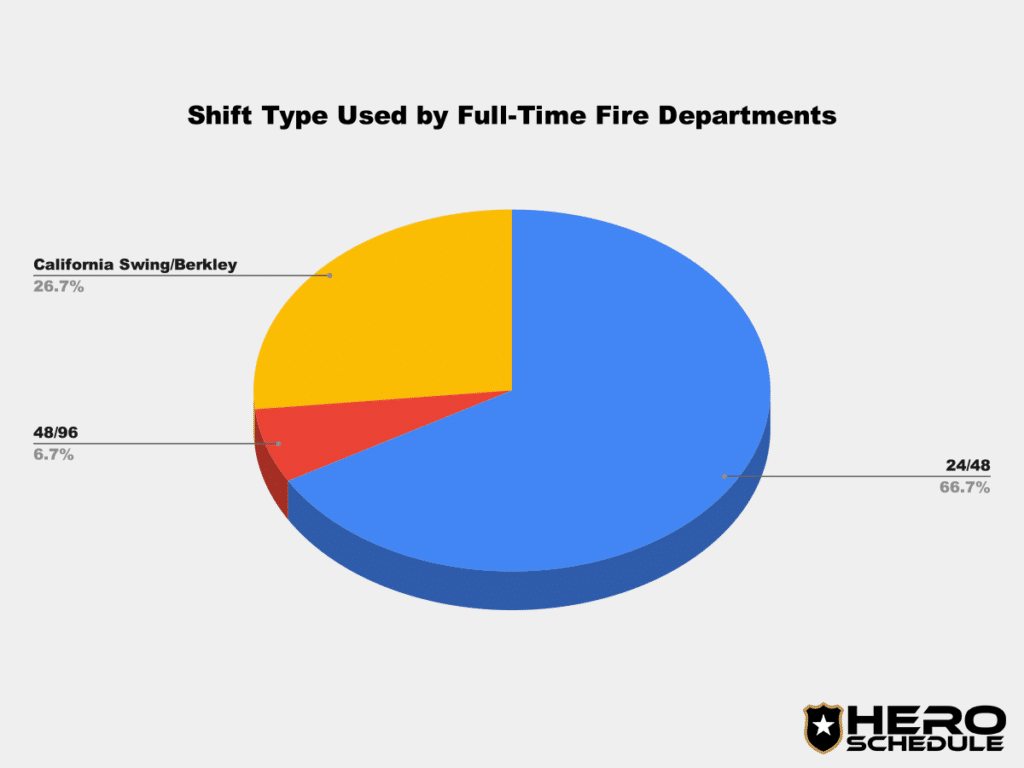
| Shift Type | Percentage |
|---|---|
| 24/48 | 67% |
| California Swing/Berkley | 27% |
| 48/96 | 7% |
The 24/48 shift type was the highest response, with 67% of full-time departments utilizing the 24 hours on/48 hours off structure. This was followed by California Swing/Berkely shifts at 27% (this is a 24 on, 24 off, 24 on, 24 off, 24 on and 96 off structure – or some close variation). 48/96 shifts were least popular, only being used by 7% of full-time departments.
Which shift type is most popular among the largest departments? Four of the top five largest agencies utilize a 24/48 shift schedule type.
In Iowa, the average full-time fire department employs 84 firefighters on average. The largest department has 300 full-time firefighters and the smallest has 16 full-time firefighters.
Volunteer Fire Department Shift Types
Since volunteer fire departments do not usually have a set schedule, we asked volunteer departments whether they have a “paged out” or “on call” basis. We consider this distinction to be a “shift type.” For the sake of this survey, paged-out means firefighters carry a pager (or pager-type device) and respond to calls remotely. On-call means firefighters have assigned times (paid or unpaid) where they must be ready to respond, whether or not they are at the firehouse.
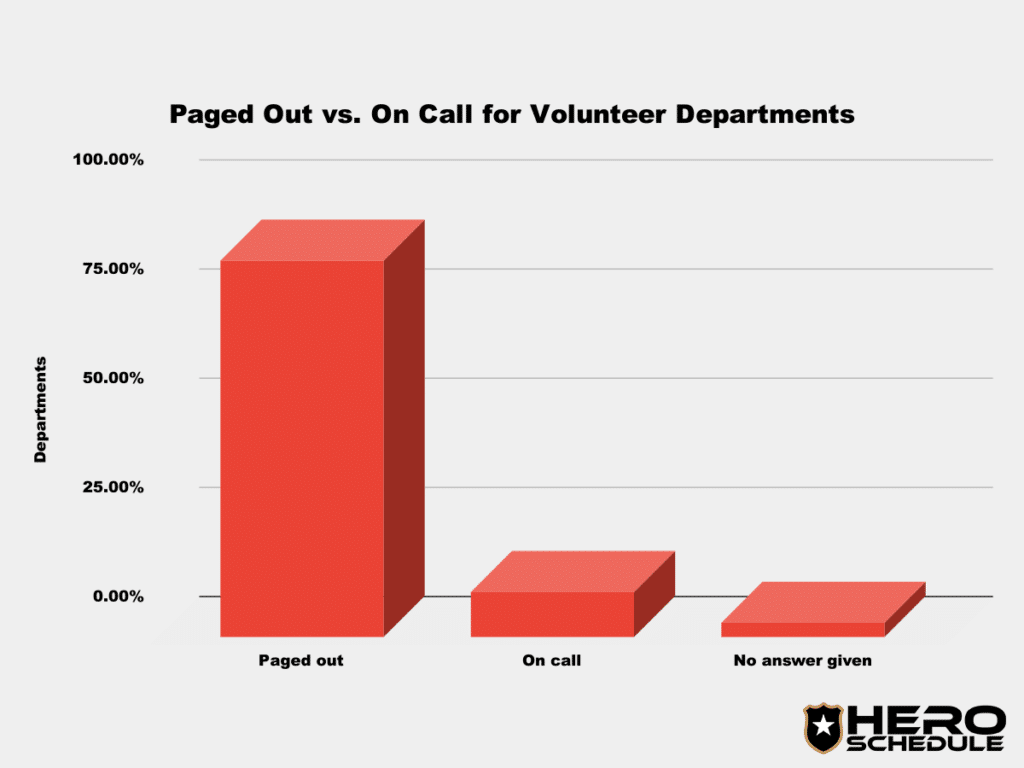
| Answer Choice | Departments |
|---|---|
| Paged-out | 86% |
| On-call | 10% |
| No answer given | 3% |
Eighty six percent of respondents said their department operates on a “paged out” basis, meaning firefighters are not actively at a fire station when a call goes out. Ten percent of departments said they have an “on-call” program, with some departments reimbursing firefighters for their time. Three percent of volunteer departments did not respond to this question on our survey.
Another question on the survey asked about meetings and trainings held during the year. Volunteer fire departments conduct 34 meetings per year on average according to our data. This figure combines training sessions, business meetings, and work nights.
Some departments broke down their responses between administrative meetings versus training. Sixty-three percent of meetings are training, with thirty-seven percent being administrative meetings.
There are 27.3 firefighters on average in an Iowa volunteer fire department. The smallest department has 17 members, while the largest has 48 members. Volunteer departments respond to an average of 248 calls per year.
Call attendance requirements
We asked volunteer departments whether or not they have call attendance requirements.
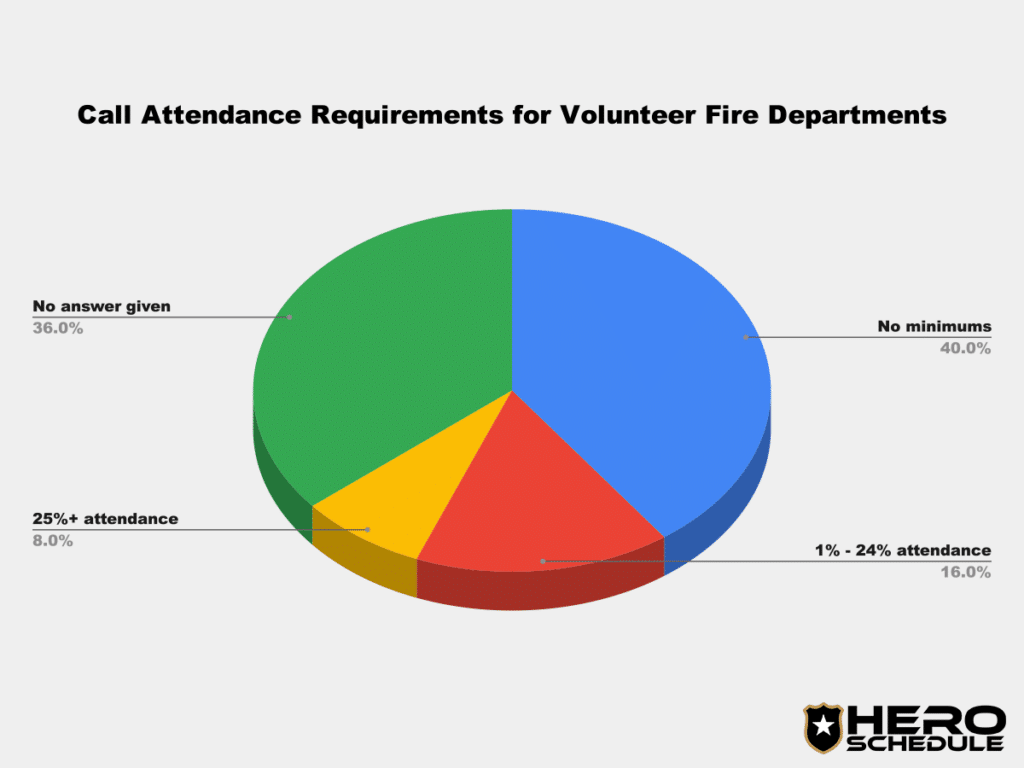
| Requirement | Percentage |
|---|---|
| No minimums | 40% |
| 1%-24% attendance | 16% |
| 25%+ attendance | 8% |
| No answer given | 36% |
Of the departments who responded to this question, forty percent of departments did not have any minimums. Sixteen percent have up to a 24% call attendance requirement. Eight percent have a 25%+ attendance requirement.
Thirty-six percent of volunteer departments did not respond to this question.
Hybrid Fire Department Shift Types
A hybrid department combines full-time, part-time, and volunteer elements. There are an average of 38.7 firefighters in an Iowa hybrid fire department – which is around half the size of the average full-time department.
Full-time staff
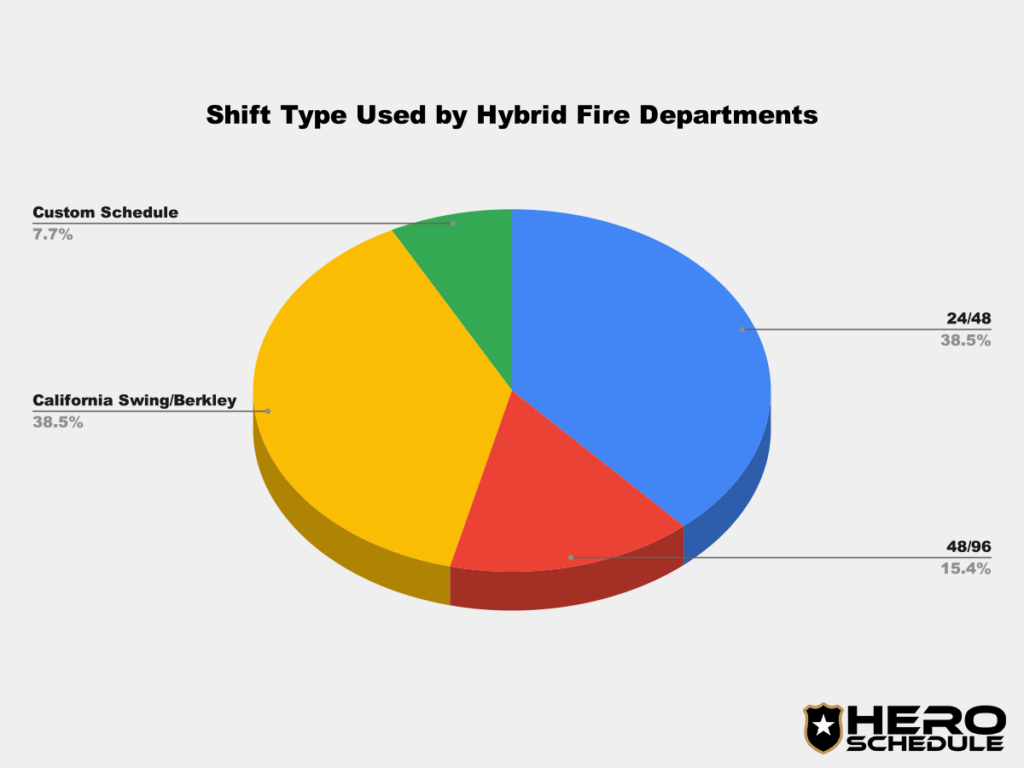
| Shift Type | Percentage |
|---|---|
| 24/48 | 39% |
| California Swing/Berkley | 39% |
| 48/96 | 15% |
| Custom Schedule | 8% |
California/Berkley and 24/48 schedules were tied at 39% for highest use in hybrid departments. Fifteen percent of hybrid departments chose the 48/96 schedule. Eight percent created a custom schedule that could not be fit into a common schedule type.
A notable trend: Hybrid departments steer away from the 24/48 structure that dominates full-time departments, in favor of California Swing, 48/96, and custom schedules.
Volunteer & part-time staff
Sixty-two percent of hybrid departments rely on volunteer firefighters to staff up their schedule. We asked whether they use a paged-out or on-call method.
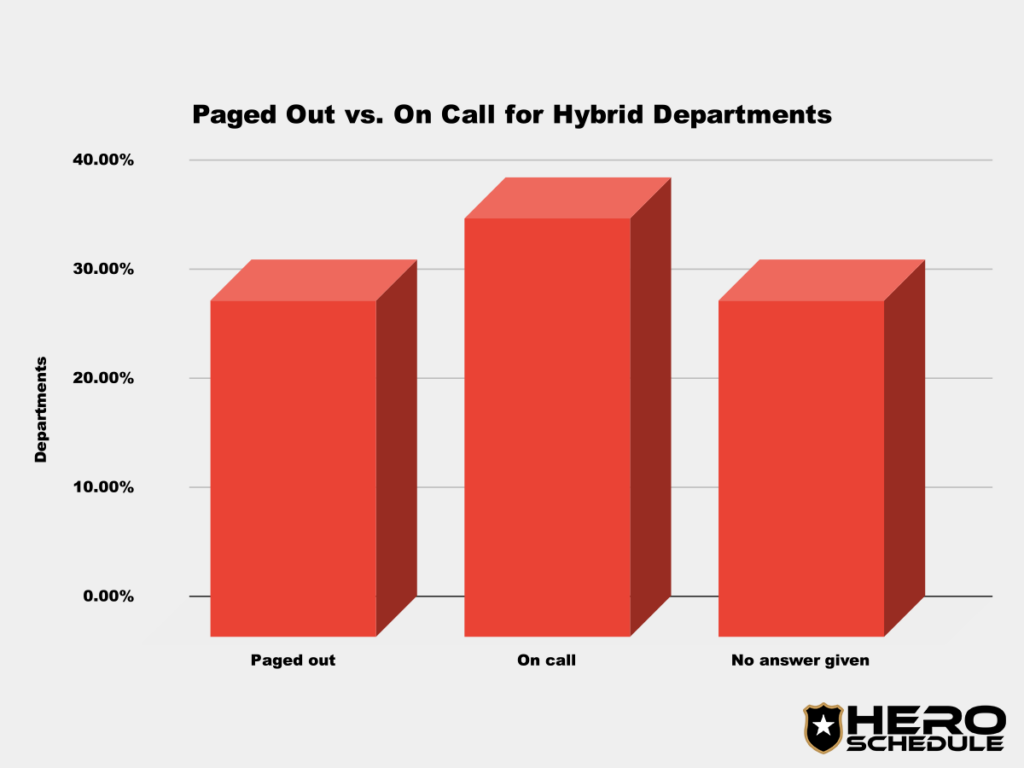
| Answer Choice | Departments |
|---|---|
| On-call | 38% |
| Paged-out | 31% |
| No answer given | 31% |
Hybrid departments rely heavily on the on-call system, with 38% of departments reflecting this in their response. This is likely due to the nature of part-time work and paid-on-call programs. Thirty-one percent said volunteer members are paged-out to emergency calls. Thirty-one percent of hybrid departments did not give us a direct answer on this question.
Statistics on Residents, Emergency Calls & Firefighters in Iowa
To help provide context for the survey, we also asked fire chiefs about their jurisdictions, emergency call data, and number of firefighters under their command.
Residents in jurisdiction
Full-time departments have an average of 71,819 residents under their jurisdiction. Volunteer departments have an average of 5,536 residents in their jurisdiction. Hybrid departments have 19,739 residents on average.
The survey covers 1.49 million residents in total. The population of Iowa is currently 3.4 million, for context.
Number of emergency calls statewide
Fire chiefs self-reported a total of 175,951 emergency calls in the prior year. Full-time fire departments average 9,555 calls per year. Volunteer departments average 248 calls per year. Hybrid departments respond to 1,976 calls per year on average.
Number of firefighters in survey
There are 2,567 firefighters counted in this survey. Full-time departments employ 1,271 firefighters, volunteer departments oversee 793 firefighters, and hybrid departments manage 503 firefighters.
Call-to-Firefighter ratio
We also looked at the call-to-firefighter ratio, which is the number of emergency calls a department receives in a year, divided by the number of firefighters. This is a useful metric as to what type of workload is seen by each department type.
Yearly Emergency Calls / # of Firefighters = Call-to-Firefighter Ratio
| Department Type | Call-to-Firefighter Ratio |
|---|---|
| Full Time | 113:1 |
| Volunteer | 9:1 |
| Hybrid | 51:1 |
| All Department Types | 69:1 |
Full-time departments have the highest call-to-firefighter ratio, at 113:1. This is in large part due to handing a significant number of medical calls. Volunteer departments have a 9:1 call-to-firefighter ratio. Hybrid departments have a 51:1 call-to-firefighter ratio.
Calls-to-Residents ratio
The call-to-residents ratio looks at how many emergency calls are received relative to the number of residents in a department’s jurisdiction. The smaller the number, the larger the call volume relative to the number of a jurisdiction’s residents.
| Department Type | Calls-to-Residents Ratio |
|---|---|
| Full-Time | One call for every 7.5 residents |
| Volunteer | One call for every 23.1 residents |
| Hybrid | One call for every 9.9 residents |
| All Department Types | One call for every 8.5 residents |
Full-time departments have a higher call-to-resident ratio, in large part due to servicing medical calls and being responsible for a larger proportion of people. Hybrid departments were closer to volunteer departments, since these department types tend to be in smaller population centers.
Interesting Anecdotes & Trends
The survey produced a lot of additional information about each department that could not be neatly categorized into hard statistics. We reflected on all the responses and made several observations.
- Several volunteer agencies noted recruitment problems and difficulties in getting citizens to volunteer. A particular volunteer fire chief said, “One of our biggest challenges is getting younger members to join and give the dedication that is needed.”
- Some departments reported call numbers split between medical and fire. Roughly 70-80% of the calls were medical-related.
- Part-time firefighters and those who are “paid-on-call” usually have to work some sort of minimum. These minimums were very unique to each department. Some responses included:
- One shift per month minimum
- Eight to twelve hours per week minimum
- Twenty-four hours per month minimum
- One shift per week minimum
- Six hours per month minimum
- Twelve hours per shift each month minimum
- A fire chief for a volunteer department noted, “Community and businesses at large need to understand the importance of responding to calls, trouble alarms, and training, as to the large impact with ISO.”
- Several departments are working on incorporating HazMat teams and technical water rescue teams into their departments.
Conclusion
A huge thank you to all fire chiefs who participated in this survey. Each of you had helpful and thorough responses. We hope to publish more content like this in the future, along with interviews and questions of things happening in firefighting. If you have any questions at all, you can reach out to me personally at isaac@heroschedule.com.
P.S. Get on the exclusive mailing list that receives a sneak preview of our next article. You can unsubscribe at any time!

Isaac is the Marketing Director at Hero Schedule.
Isaac is the Marketing Director at Hero Schedule.
Get a sneak preview of the NEXT article we write on Iowa fire departments.

